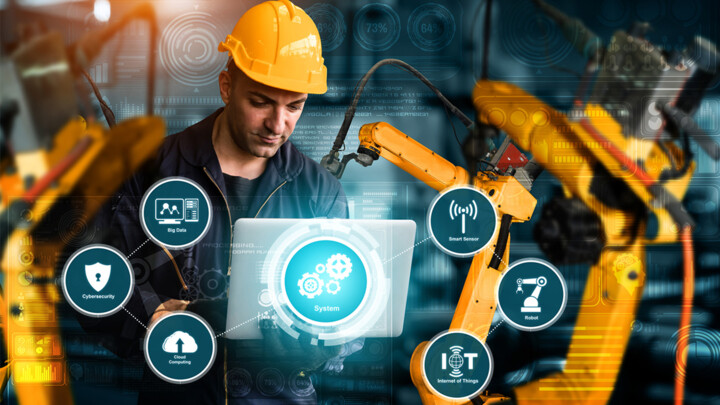Industry 4.0: Rising to the Cybersecurity Challenge in Smart Manufacturing
The article discusses the smart manufacturing sector by highlighting its characteristics and illustrating what the main challenges are for enterprises in the sector, and how TANGO project proposes a solution to mitigate cybersecurity risks through a dedicated case study.

©NanoStockk | istockphoto.com
This article was initially published on the TANGO website and is republished here with the author’s permission.
The context: Industry 4.0
The rapid evolution of information and communication technologies (ICT) has enabled the emergence of highly disruptive technologies, such as Big Data, cloud computing, the Internet of Things (IoT), and artificial intelligence. The fourth industrial revolution, namely Industry 4.0, is currently underway. The term was first seen in 2011 at the Hannover Fair in Germany. It originated from a project of high-tech strategy developed by the German government. [1] Industry 4.0 brings forward the developments of the third industrial revolution – automation and machinery leading to automated production – by adding the “intelligent” feature on production systems through real-time communication and collaboration. As stated by McKinsey, Industry 4.0 builds on four technology pillars [2]:
- Connectivity, data and computational power
- Analytics, artificial intelligence, machine learning
- Human-machine interactions: augmented reality, robotics, and automations
- Advanced engineering, such as additive manufacturing
After the widespread adoption of the Industry 4.0 concept extended globally, discussions of Industry 5.0 had already begun. The name is taken from the concept of Society 5.0 envisioned by Japan as the future of society, defined as “a human-centered society that balances economic advancement with the resolution of social problems by a system that highly integrates cyberspace and physical space.” [3] The European Union’s approach to Industry 5.0 provides a vision of the industry that shifts the focus to the individual, human progress, and well-being. In other words, Industry 5.0 complements the existing “Industry 4.0” approach by putting research and innovation at the service of the transition to a sustainable, human-centric and resilient European industry. [4]
Industry 4.0 not only affects the manufacturing sector but has cross-sectoral applications in all industries, extending its impact to society and the marketplace, hence on products, consumer purchasing experiences, and the labor market.
What is smart manufacturing?
The manufacturing sector, in the definition of the US government, “comprises establishments engaged in the mechanical, physical, or chemical transformation of materials, substances, or components into new products,” as well as those engaged in “assembling of component parts of manufactured products” for purposes other than construction. [5]
The manufacturing industry has been profoundly impacted at the forefront by new technologies and their applications, which have led to a profound transformation of the sector over the past decade. The new paradigm adopted with Industry 4.0 serves as an enabler for manufacturing that sees the integration of the “smart” component into manufacturing systems through the use of new information and communication technologies, moving to Smart Manufacturing Systems (SMS).
Although there is no shared universal definition of smart manufacturing in the literature, it is possible to list its constituent elements related to the technological characteristics and underlying principles common to smart systems: enabling technologies (data analytics, cloud computing, IoT, Big Data, 3D printing, Cyber-Physical Systems) and principles of interoperability, modularity, real-time responses, and traceability. [6]
CESMII, the Smart Manufacturing Institute, provides the following definition: “Smart manufacturing is the information-driven, event-driven, efficient, and collaborative orchestration of business, physical, and digital processes within plants, factories, and across the entire value chain. In smart manufacturing, resources and processes are integrated, monitored, and continuously evaluated with the sensing, information, process modelling, predictive analytics, and workflow needed to automate routine actions, and prescribe action for non-routine situations. [...]” [7]
Underlying the processes, there is the interconnection component. Smart Manufacturing integrates different types of technologies that exploit the interconnection between machinery and control tools in order to improve production performance and optimize the resources needed to implement Big Data, artificial intelligence, and advanced robotics technologies. The use of the set of these technologies, and the interoperability of the tools adopted, aims to improve performance in terms of cost-effectiveness, time savings, better time-to-market and thus increased market responsiveness, greater flexibility, and the ability to control systems remotely. [8]
It is clear, therefore, that the use of the Internet component within the manufacturing industry enables production processes to be greatly streamlined, human intervention to be reduced where it is not necessary, and allows a large amount of information to be acquired and processed.
Within the industry, implementing IoT technology to obtain data from manufacturing enterprises can generate a huge amount of data, which is nowadays easier to manage thanks to the evolution of computational power and the cloud. Such data must be analyzed through appropriate software, incorporating a security system to safeguard and analyze all data.
Challenges and risks
The challenges associated with smart manufacturing are related to the complexity of creating and integrating systems. These challenges concern not only the technologies to be adopted, which must be properly integrated into the production system, but also the acquisition of these technologies as well as their proper implementation to achieve the best results in terms of productivity and resource utilization. Specifically, the challenges can be [9]:
- Strategic, in identifying the business needs and the correct strategy to achieve the company’s objectives, including in terms of technology and financial resources
- Operational, in systems integration, process design, data ecosystem creation, automation, and security
- Cultural, in change management, managerial skills and capabilities, and performance measurement
- Market, in meeting customer needs in terms of products, service level, and availability
Among the perceived operational risks, the most prevalent one is data-related and, in particular, cybersecurity: due to the inherent component of interconnectivity, not “only” data acquired and used by businesses are at risk, but the whole system of physical processes, intellectual property, people, and technologies related to them. The interconnectedness of IoT tools with databases on the cloud and information networks makes them vulnerable and gives them potentially dangerous targets for attacks. According to Capgemini’s 2021 survey of a sample of 950 organizations, 80 percent of them agree that cybersecurity is a critical component in smart factories, and 40 percent of the organizations surveyed said they had been the victim of a cyberattack that affected their smart factories. [10]
Smart manufacturing companies deal with cyber-physical, connected systems rather than closed ones. Since IoT cybersecurity refers to a large number of connected devices, the concept of security itself is interconnected with a number of security disciplines which might have a ripple effect. According to the findings from research conducted by Deloitte, compounding the adoption of smart factory technologies is the fact that information technology (IT) management is often not synchronized with operational technology (OT) management, which can further expose companies to cyber attacks stemming from unknown or underestimated vulnerabilities, often occurring through the use of malware. [11]
Because cybersecurity risks are strongly perceived by organizations, it is important that the complex production systems and underlying technologies are secured in the best possible way for a successful implementation of smart manufacturing. Therefore, not only the awareness that such risks may occur is relevant, but also the preparedness to address them with appropriate security measures – at the level of policies, organizational practices, and techniques – as well as the implementation of cybersecurity at the level of the entire organization.
TANGO’s solution and smart manufacturing use case
TANGO project will develop a solution for secure, trustworthy, and environmentally sustainable data management, with an underlying technology that will allow the development of trustworthy, accountable, and privacy-preserving digital tools to enable cross-sector data sharing. To this end, TANGO will validate the solution across six data-sharing use cases in different sectors, one of them being focused on smart manufacturing, where risks and vulnerabilities arise from internal and external cyberthreats.
One of the goals of the TANGO project is to implement trustworthy and accountable data management, storage, and sharing mechanisms for manufacturers. These mechanisms will protect corporate, employee, and customer data on real-time operating platforms. The project emphasizes safeguarding manufacturers’ intellectual property (IP) to prevent theft and ensure resistance, resilience, and future-proofing against cyberattacks.
TANGO enables manufacturers to work closely with third parties and contractors while ensuring continuous reassurance and accountability for data access. GDPR-compliant data handling policies based on trustworthy and accountable data sharing will enhance the security of the RIAS Data Handling infrastructure and safeguard the RIAS and IKEA IP and data ecosystems. Additionally, the project is focused on detecting and preventing cyberattacks on IoT devices used in the production chain. Overall, TANGO aims to provide a secure platform for data exchange and communication between customers and manufacturers while safeguarding customer privacy.
References:
[1] Xu, X., Lu, Y., Vogel-Heuser, B., & Wang, L. (2021). Industry 4.0 and Industry 5.0—Inception, conception and perception. Journal of Manufacturing Systems, 61, 530-535. ISSN: 0278-6125. https://doi.org/10.1016/j.jmsy.2021.10.006.
[2] McKinsey & Company. (2022). What are Industry 4.0, the fourth industrial revolution, and 4IR? McKinsey Explainers. Retrieved from https://www.mckinsey.com/featured-insights/mckinsey-explainers/what-are-industry-4-0-the-fourth-industrial-revolution-and-4ir#/
[3] Cabinet Office, Government of Japan. (n.d.). Society 5.0. Retrieved from https://www8.cao.go.jp/cstp/english/society5_0/index.html
[4] European Commission. (n.d.). Industry 5.0. Retrieved from https://research-and-innovation.ec.europa.eu/research-area/industrial-research-and-innovation/industry-50_en
[5] National Institute of Standards and Technology (NIST). (2017). What Is Manufacturing? Why Does the Definition Matter?. Retrieved from https://www.nist.gov/system/files/documents/2017/02/08/r44755.pdf
[6] Junior, A. A. de S., Pio, J. L. de S., Fonseca, J. C., De Oliveira, M. A., Valadares, O. C. de P., & Da Silva, P. H. S. (2021). The State of Cybersecurity in Smart Manufacturing Systems: A Systematic Review. European Journal of Business and Management Research, 6(6), 188–194. https://doi.org/10.24018/ejbmr.2021.6.6.1173
[7] CESMII (Clean Energy Smart Manufacturing Innovation Institute). (n.d.). What is Smart Manufacturing? Retrieved from https://www.cesmii.org/about/what-is-smart-manufacturing/
[8] Phuyal, S., Bista, D., & Bista, R. (2020). Challenges, Opportunities and Future Directions of Smart Manufacturing: A State of Art Review. Sustainable Futures, 2, 100023. ISSN: 2666-1888. https://doi.org/10.1016/j.sftr.2020.100023.
[9] Tuptuk, N., & Hailes, S. (2018). Security of smart manufacturing systems. Journal of Manufacturing Systems, 47, 93-106. ISSN: 0278-6125. https://doi.org/10.1016/j.jmsy.2018.04.007.
[10] Capgemini Research Institute. (2022). Smart & Secure: Why smart factories need to prioritize cybersecurity. Retrieved from https://prod.ucwe.capgemini.com/wp-content/uploads/2022/06/Cybersecurity-in-Smart-Factories_Web-2.pdf
[11] Deloitte. (2016). Cyber risk in advanced manufacturing. Retrieved from https://www2.deloitte.com/content/dam/Deloitte/us/Documents/manufacturing/us-manu-cyber-risk-in-advanced-manufacturing.pdf
Jasmin Jabbarpour is Project Manager and Research Associate at the Lisbon Council. Previously, she worked as a business consultant in different advisory firms and start-up companies, where she took part in several projects in business strategy and European research. She holds a master’s degree in business markets and strategies from the Catholic University of Milan and a bachelor’s degree in business from the University of Parma.
Please note: The opinions expressed in Industry Insights published by dotmagazine are the author’s or interview partner’s own and do not necessarily reflect the view of the publisher, eco – Association of the Internet Industry.






